Команда ping — это сетевой инструмент для проверки работоспособности удаленной системы. Другими словами, команда определяет, доступен ли определенный IP-адрес или хост. Ping использует протокол сетевого уровня, называемый Internet Control Message Protocol (ICMP), и доступен во всех операционных системах.
С другой стороны, номера портов принадлежат протоколам транспортного уровня, таким как TCP и UDP. Номера портов помогают определить, куда пересылается Интернет или другое сетевое сообщение, когда оно приходит.
В этом руководстве вы узнаете, как проверить связь с портом в Windows и Linux с помощью различных инструментов.
Можно ли пропинговать конкретный порт?
Сетевые устройства используют протокол ICMP для отправки сообщений об ошибках и информации о том, успешна ли связь с IP-адресом. ICMP отличается от транспортных протоколов, поскольку ICMP не используется для обмена данными между системами.
Ping использует пакеты ICMP, а ICMP не использует номера портов, что означает, что порт не может быть опрошен. Однако мы можем использовать ping с аналогичным намерением — чтобы проверить, открыт порт или нет.
Некоторые сетевые инструменты и утилиты могут имитировать попытку установить соединение с определенным портом и ждать ответа от целевого хоста. Если есть ответ, целевой порт открыт. В противном случае целевой порт закрывается или хост не может принять соединение, потому что нет службы, настроенной для прослушивания подключений на этом порту.
Как пропинговать определенный порт в Linux?
Вы можете использовать три инструмента для проверки связи порта в Linux:
- Telnet
- Netcat (NC)
- Network Mapper (nmap)
Пинг определенного порта с помощью Telnet
Telnet — это протокол, используемый для интерактивной связи с целевым хостом через соединение виртуального терминала.
1. Чтобы проверить, установлен ли уже telnet, откройте окно терминала и введите:
telnet

2. Если telnet не установлен, установите его с помощью следующей команды
- Для CentOS/Fedora:
yum -y install telnet - Для Ubuntu:
sudo apt install telnet
3. Чтобы пропинговать порт с помощью telnet, введите в терминале следующую команду:
telnet [address] [port_number]
Где [address] — это домен или IP-адрес хоста, а [port_number] — это порт, который вы хотите проверить.
telnet google.com 443

Если порт открыт, telnet устанавливает соединение. В противном случае он указывает на сбой.
4. Чтобы выйти из telnet, нажмите Ctrl +] и введите q.
Пинг определенного порта с помощью Netcat
Netcat (nc) позволяет устанавливать соединения TCP и UDP, принимать оттуда данные и передавать их. Этот инструмент командной строки может выполнять множество сетевых операций.
1. Чтобы проверить, установлен ли netcat:
- Для Debian, Ubuntu и Mint: введите
netcat -h - Для Fedora, Red Hat Enterprise Linux и CentOS:
ncat -h
2. Если netcat не установлен, выполните в терминале следующую команду:
sudo apt install netcat
3. Чтобы пропинговать порт с помощью netcat, введите следующее:
nc -vz [address] [port_number]

Выходные данные информируют пользователя об успешном подключении к указанному порту. В случае успеха — порт открыт.
Пинг определенного порта с помощью Nmap
Nmap — это сетевой инструмент, используемый для сканирования уязвимостей и обнаружения сети. Утилита также полезна для поиска открытых портов и обнаружения угроз безопасности.
1. Убедитесь, что у вас установлен Nmap, введя nmap -version в терминал.

Если Nmap установлен, вывод информирует пользователя о версии приложения и платформе, на которой он работает.
2. Если в вашей системе нет Nmap, введите следующую команду:
- Для CentOS или RHEL Linux:
sudo yum install nmap - Для Ubuntu или Debian Linux:
sudo apt install nmap
3. После установки Nmap в системе используйте следующую команду для проверки связи определенного порта:
nmap -p [port_number] [address]

Выходные данные информируют пользователя о состоянии порта и типе службы, задержке и времени, прошедшем до завершения задачи.
4. Чтобы проверить связь с более чем одним портом, введите nmap -p [number-range] [address].
Синтаксис [number-range]— это диапазон номеров портов, которые вы хотите пропинговать, разделенные дефисом. Например:
nmap -p 88-93 google.com

Как пропинговать определенный порт в Windows?
Проверить связь с портом в Windows можно двумя способами:
- Telnet
- PowerShell
Пинг определенного порта с помощью Telnet
Перед использованием telnet убедитесь, что он активирован:
- Откройте панель управления.
- Щелкните «Программы», а затем «Программы и компоненты».
- Выберите «Включение или отключение компонентов Windows».
- Найдите клиент Telnet и установите флажок. Щелкните ОК.
Готово! Вы активировали клиент Telnet в системе.
После завершения активации можно пропинговать порт с помощью telnet. Для этого:
1. Введите cmd в поиске в меню «Пуск». Щелкните на приложение Командная строка.
2. В окне командной строки введите
telnet [address] [port_number]
Где [address] — это домен или IP-адрес хоста, а [port_number] — это порт, который вы хотите проверить.

Выходные данные позволяют узнать, открыт ли порт и доступен ли он, иначе отображается сообщение об ошибке подключения.
Пинг определенного порта с помощью PowerShell
PowerShell — это текстовая оболочка, которая по умолчанию поставляется с Windows.
Чтобы проверить связь с портом с помощью PowerShell, выполните следующие действия:
1. Введите PowerShell в поиске в меню «Пуск». Щелкните приложение Windows PowerShell.
2. В окне командной строке PowerShell введите:
Test-NetConnection [address] -p [port_number]

Если порт открыт и соединение прошло успешно, проверка TCP прошла успешно. В противном случае появится предупреждающее сообщение о том, что TCP-соединение не удалось.
Заключение
Теперь вы знаете, как выполнить эхо-запрос и проверить, открыт ли порт, с помощью нескольких сетевых инструментов и утилит в Linux и Windows.
Home » KB » SysAdmin » How to Ping Specific Port Number in Linux, Windows and MacOS
The ping command is a network tool for checking whether a certain IP address or host is accessible using a network layer protocol called Internet Control Message Protocol (ICMP).
On the other hand, port numbers belong to transport layer protocols, such as TCP and UDP. Port numbers help identify where an Internet or other network message is forwarded when it arrives.
In this tutorial, you will learn how to ping a port in Windows, Linux, and macOS using different tools.

Prerequisites
- A Linux, Windows, or macOS system.
- Access to the terminal.
- An account with sudo or root privileges.
Can You Ping a Specific Port?
Network devices use ICMP to send error messages and information on whether communication with an IP address is successful or not. ICMP differs from transport protocols as it is not used to exchange data between systems.
ping uses ICMP packets, and ICMP does not use port numbers, which means a port cannot be pinged. However, there are tools that can check if a port is open.
Some network tools and utilities simulate an attempt to connect to a specific port and wait to see if the target host responds. If there is a response, the target port is open. If not, the target port is closed, or the host cannot accept a connection because there is no service configured to listen for connections on that port.
How to Ping a Specific Port in Linux
There are several tools to check whether a port is open in Linux. They are:
- Telnet.
- Netcat (nc).
- Network Mapper (nmap).
- Curl.
Ping a Port Using Telnet
Telnet is a protocol for interactive communication with the target host via a virtual terminal connection. To ping a port using telnet, run:
telnet [address] [port-number]The [address] is the domain or the host IP address, while [port-number] is the port you want to ping. For example, run the following:
telnet google.com 443
If the port is open, Telnet establishes a connection. Otherwise, it states a failure.
Ping a Port Using Netcat
Netcat (nc) reads and writes from connections using TCP and UDP protocols. This command-line tool performs many network operations.
To ping a port using Netcat, enter the following:
nc -vz [address] [port-number]In the command, the -v argument enables detailed output, and -z checks if the port is open without sending data.
For example, run the following;
nc -vz google.com 443
The output states whether the connection to the specified port is successful. If it is successful, the port is open.
Ping a Port Using Nmap
Nmap is a network tool used for vulnerability scanning and network discovery. The utility is also useful for finding open ports and detecting security risks.
Note: Be aware of legal ramifications regarding improper Nmap use, such as flooding a network or crashing a system.
Use the following command to ping a specific port with Nmap:
nmap -p [port-number] [address]The -p option specifies the port or port range you want to scan on the target address. For example, run the following:
nmap -p 443 google.com
The output informs the user about the port’s state and service type, latency, and the time elapsed until the task completion.
To ping more than one port, enter:
nmap -p [number-range] [address]The [number-range] is the port number range you want to ping, separated by a hyphen.
For example:
nmap -p 88-93 google.com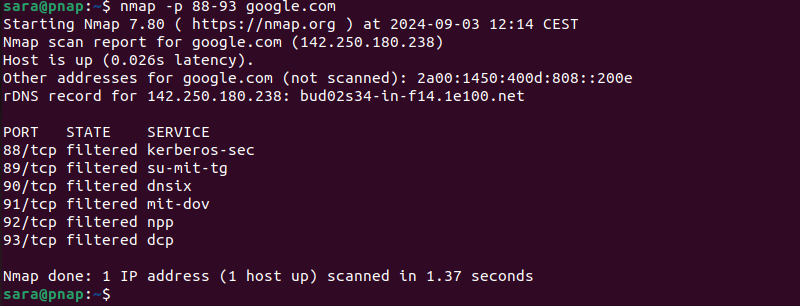
Ping a Port Using curl
The curl command is designed to make HTTP/HTTPS requests. However, use curl to check if a specific port is open by attempting an HTTP or HTTPS connection to that port.
The syntax is:
curl [address]:[port-number]For example, to check if port 443 (used for HTTPS) is open on Google using curl, run:
curl https://google.com:443
How to Ping a Specific Port in Windows
Learn how to test the availability of a specific port in Windows using different tools. The following text explains how to ping a specific port in Windows using Telnet and PowerShell.
Ping a Port Using Telnet
Before using Telnet, make sure it is activated. To do that, follow these steps:
1. Open the Control Panel.

2. Click Programs.
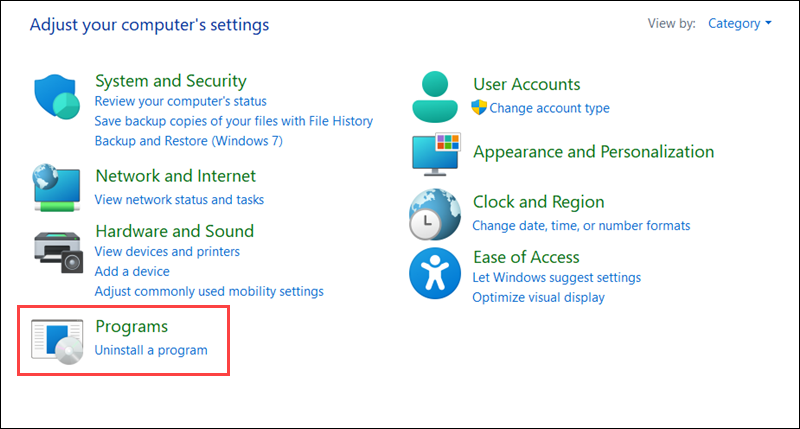
3. Select Programs and Features.
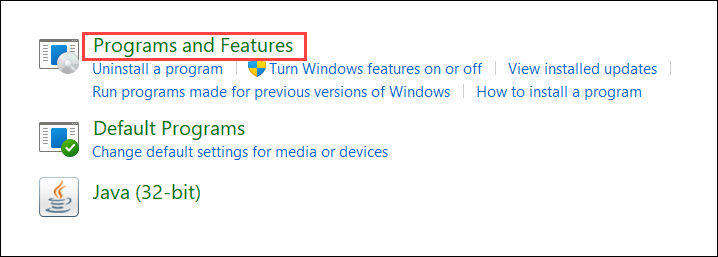
4. Select Turn Windows features on or off.

5. Find Telnet Client and check the box. Click OK.
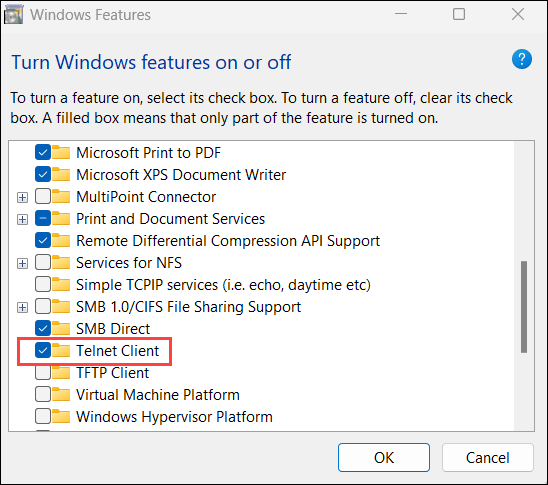
You activated the Telnet Client on the system. After completing the activation, access the cmd and use the following command.
telnet [address] [port-number]The [address] is the domain or the host’s IP address, while [port-number] is the port number you want to ping. For example, run:
telnet google.com 443If the connection is successful, you’ll see a blank screen or a message indicating the connection is open.
Ping a Port Using PowerShell
PowerShell is a text-based shell that comes with Windows by default. To ping a port using PowerShell, enter the following in the PowerShell prompt window:
Test-NetConnection [address] -p [port-number]For example, run:
Test-NetConnection google.com -p 443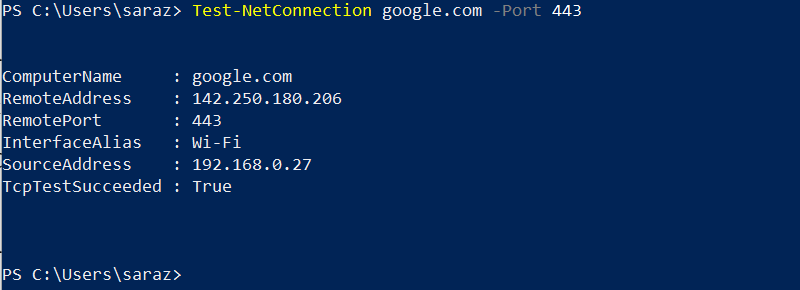
The TCP test is successful if the port is open and the connection is established. Otherwise, a warning message appears saying the TCP connection failed.
How to Ping a Specific Port in macOS
There are several ways to test whether a specific port is open on a remote server using tools available on macOS, such as Netcat, Telnet, and Curl.
Read the following text to learn how to ping a specific port in macOS.
Ping a Port Using nc (Netcat)
To test if a specific port is open, use the following command:
nc -zv [address] [port-number]For example, run:
nc -zv google.com 443
The -z option tells nc to scan for open ports without sending any data. The -v enables verbose mode. Therefore, it provides detailed output.
Ping a Port Using Telnet
The telnet command also checks if a specific port is open. To do it, run the following:
telnet <address> <port_number>For example, run:
telnet google.com 443You’ll see a blank screen if the connection is successful.
Ping a Port Using curl
The curl command is helpful for testing HTTP or HTTPS ports (like 80 or 443). The syntax is:
curl -I [address]For example, run the following:
curl -I https://google.com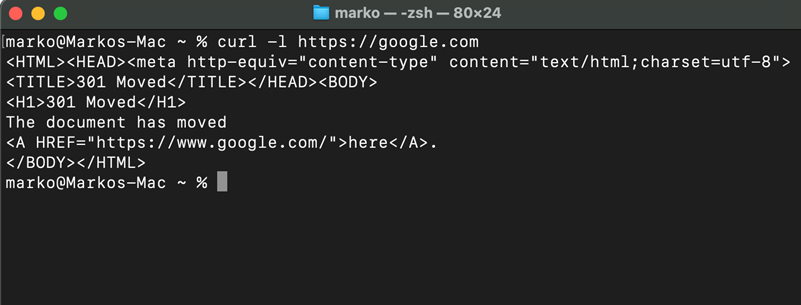
Conclusion
This article explained several ways to check whether a port is open in Linux, Windows, and macOS. It included instructions for popular tools such as Curl, Nmap, and Netcat.
Next, learn how to open a port in Linux.
Was this article helpful?
YesNo
Pinging a port is a useful way to test connectivity and ensure that a specific service on a target machine is accessible. While the traditional ping command checks if a host is reachable, it doesn’t support ports directly. To check the status of a port, alternative methods like telnet, PowerShell, or third-party tools are required.
This guide explains how to “ping” a port on Windows using practical techniques.
Pinging a port can help:
1. Troubleshoot Network Issues: Ensure a specific service is running and reachable.
2. Test Firewalls: Verify that a firewall isn’t blocking a port.
3. Check Service Availability: Confirm that an application or server is accessible on a given port.
Method 1: Using Telnet
Step 1: Enable Telnet (If Not Already Installed)
- Press Win + S, type
Turn Windows features on or off, and select it. - Scroll down and check Telnet Client.
- Click OK and wait for the installation to complete.
Step 2: Use Telnet to Ping a Port
-
Open Command Prompt:
– Press Win + S, typecmd, and hit Enter. -
Type the following command:
bash
telnet <hostname> <port> -
Replace
<hostname>with the target IP address or domain and<port>with the desired port number.
Example:
bash
telnet 192.168.1.1 80
- If the connection is successful, the screen will go blank. If not, you’ll see an error message indicating the port is closed or unreachable.
Method 2: Using PowerShell
Step 1: Test the Port with PowerShell
-
Open PowerShell:
– Press Win + X and select Windows PowerShell or Terminal. -
Run the following command:
powershell
Test-NetConnection -ComputerName <hostname> -Port <port> -
Replace
<hostname>with the target IP or domain and<port>with the desired port number.
Example:
powershell
Test-NetConnection -ComputerName google.com -Port 443
- PowerShell will display the connectivity results, including whether the port is open or closed.
If you prefer a graphical interface or need additional features, third-party tools can help.
Recommended Tools:
-
Netcat (nc):
– Download and install Netcat on Windows.
– Use the following command in Command Prompt:
bash
nc -zv <hostname> <port> -
Nmap:
– Install Nmap from Nmap.org.
– Run the following command to scan the port:
bash
nmap -p <port> <hostname> -
Angry IP Scanner:
– A user-friendly tool for scanning IP addresses and ports.
– Download from Angry IP Scanner and follow the GUI instructions.
Comparison of Methods
| Method | Ease of Use | Best For |
|---|---|---|
| Telnet | Moderate | Simple port checks on TCP |
| PowerShell | Easy | Quick and detailed connectivity results |
| Third-Party Tools | Easy | Advanced scanning and testing |
FAQs About Pinging Ports
Can I Ping a Port Directly with the Ping Command?
No, the ping command in Windows does not support ports. It checks host reachability but not specific services or ports.
What Happens If a Port Is Closed?
If a port is closed, you won’t be able to establish a connection, and the tool will return an error or failure message.
How Do I Check UDP Ports?
Use tools like Nmap or specialized network scanners, as most methods above focus on TCP ports.
Pro Tips for Pinging Ports
- Check Firewalls: Ensure no firewalls are blocking the port on the target machine.
- Verify Service Status: Make sure the service associated with the port is running on the target host.
- Use Tools Wisely: PowerShell and Telnet are ideal for simple checks, while tools like Nmap provide more comprehensive scans.
Conclusion
Pinging a port on Windows is an essential skill for network troubleshooting and service testing. While the traditional ping command doesn’t support ports, tools like Telnet, PowerShell, and third-party applications make it easy to check port availability.
Choose the method that best fits your needs, and ensure your network remains secure and functional. Happy troubleshooting!
To ping an IP address with a specific port, you will need to use a command line tool called Netcat. Netcat is a versatile tool that can be used for a variety of purposes, including port scanning, file transfers, and port forwarding. To install Netcat on Windows 10, you can use the Chocolatey package manager. Once Netcat is installed, you can use the following command to ping an IP address with a specific port:
nc -v -n -z -w 1
For example, to ping the IP address 192.168.1.1 on port 80, you would use the following command:
nc -v -n -z -w 1 192.168.1.1 80
How do I ping an IP with a port number?
How do you ping a port to see if it is open?
To ping a port to see if it is open, you can use the telnet command. For example, if you want to ping port 80 on http://www.google.com, you would type telnet http://www.google.com 80. If the port is open, you will see a blank screen. If the port is closed, you will see a message that says «Connected to http://www.google.com.”
How can I test my port connectivity?
If you need to test port connectivity, the easiest way to do so is to use the telnet command. For example, if you wanted to test port 80 connectivity, you would issue the following command:
telnet 80
If the port is open, you will see a blank screen. If the port is closed, you will see a message saying «Connection refused.«
To ping an IP address in Windows 10, you can use the Command Prompt. To do this, open the Command Prompt and type «ping» followed by the IP address you want to ping. For example, to ping 8.8.8.8, you would type «ping 8.8.8.8«.
Can we ping a port?
Yes, you can ping a port. To do so, you will need to use the command prompt (for Windows) or Terminal (for Mac). At the command prompt, type «ping» followed by the IP address of the port you wish to ping. For example, if you wanted to ping port 80 on 192.168.1.1, you would type «ping 192.168.1.1:80«.
Is there a port for ping?
Yes, there is a port for ping. The port number is 7.
How do I check if port 443 is open?
To check if port 443 is open, you can use the telnet command. To do this, open a command prompt and type «telnet [hostname or IP address] 443«. If the port is open, you will see a blank screen. If the port is closed, you will see an error message.
How do I test port 8080?
To test port 8080, you can use a tool like nmap to scan for open ports on a target system. Once you have found an open port, you can then use telnet or netcat to connect to the port and test connectivity.
How do I ping an IP and port in Windows?
To ping an IP and port in Windows, you can use the telnet command. For example, to ping the IP address 1.2.3.4 on port 80, you would type the following command:
telnet 1.2.3.4 80
If the IP and port are accessible, you should see a blank screen. Pressing the Enter key will return you to the command prompt.
What is ping IP command?
The ping IP command is used to test the connectivity of a device on a network. The command sends a request to a specified IP address and waits for a reply. If the device responds, the command displays the round-trip time for the request.
How do I enable ping port?
In order to enable ping port, you will need to follow these steps:
1. Log into your router’s web interface.
2. Navigate to the port forwarding section.
3. Create a new rule that forwards traffic from the WAN (external) IP address to the LAN (internal) IP address of the device you wish to ping.
4. Save the changes and test to ensure the rule is working as expected.
To ping a specific port on Windows 10, you typically use a utility like Telnet or PowerShell, as the traditional ping command is used to test network connectivity by sending ICMP Echo Requests to an IP address. It does not allow you to specify a port number.
To ping a port on Windows 10, you will need to use the Command Prompt.
- To do this, type «cmd» into the search bar and click on the Command Prompt app.
- Once the Command Prompt is open, type «ping» followed by the IP address and the port number that you want to ping.
For example, if you wanted to ping port 80 on the IP address 192.168.1.1, you would type «ping 192.168.1.1 80» into the Command Prompt.
In order to ping an Ethernet port, you will need to have access to a computer with an Ethernet port and an Internet connection. Once you have these two things, you can ping an Ethernet port by following these steps:
- 1. Connect the computer to the Ethernet port.
- 2. Open a command prompt and type «ping [Ethernet port’s IP address].«
- 3. Press Enter.
- 4. Wait for the results of the ping test.
To ping a port on Windows 10 Using Telnet:
First, ensure Telnet is installed on your Windows 10 machine:
- Go to Control Panel.
- Choose
Programs and Features. - Select
Turn Windows features on or off. - Scroll down and check
Telnet Client. - Click OK and wait for it to install.
Once installed, open the Command Prompt and use the following command:
telnet <Hostname_or_IP> <PortNumber>
If the port is open, the window will go blank or display a connected message. If it’s closed or if there’s an issue, you’ll see a «Could not open connection» error.
Remember that even if a port is not responding to a telnet or PowerShell check, it doesn’t mean the port isn’t being used or active; it might be set to not respond, or there could be a firewall or other security measures in place. Always approach port checks and scans with caution and ensure you have permission to probe the target system.
How do I ping a specific port?
How do I test a port?
Nmap (Network Mapper) is a versatile and powerful tool for network discovery and security scanning. One of its primary uses is to check if specific ports on a system are open. Here’s how you can use Nmap to test a port:
- Install Nmap:
- If you haven’t installed Nmap on your system, you can download and install it from the official website: https://nmap.org/download.html
- Basic Port Scan:
- Open a command-line interface or terminal.
- To test a specific port, use the following command:
nmap -p <PortNumber> <Hostname_or_IP>
- Scan Multiple Ports:
- You can also test multiple ports by separating them with commas or using a range with a hyphen.

nmap -p 80,443 example.com # Tests port 80 and 443
nmap -p 20-30 example.com # Tests ports from 20 to 30 inclusive
4. Scan Most Common Ports:
- Nmap has a list of the 1,000 most common ports. To scan these, you don’t need to specify any port:
- Use the
-T4option for faster execution (be cautious as this might be flagged by intrusion prevention systems). - Use the
-voption for verbose mode to get more details. - Use the
-sVoption to determine the version of the service running on the port.
Example combining the options:
nmap -p 80,443 -T4 -v -sV example.com
Note: Always ensure you have permission to scan the target. Unauthorized scanning can be illegal and unethical. If you’re scanning a system or network that you do not own or have explicit permission to test, you could face legal consequences.
How do I check if port 22 is open?
If you are using a Windows operating system, you can use the telnet command to check if port 22 is open. Simply open the Command Prompt and type «telnet {hostname} 22«. If the port is open, you will see a blank screen. If the port is closed, you will see an error message.
If you are using a Linux operating system, you can use the nmap command to check if port 22 is open. Simply open the terminal and type «nmap -p 22 {hostname}«. If the port is open, you will see the message «22/tcp open«. If the port is closed, you will see the message «22/tcp closed«.
To ping a port in Windows, you can use the Command Prompt. To do this, open the Command Prompt and type «ping» followed by the IP address and the port number. For example, to ping port 80 on the IP address 192.168.1.1, you would type «ping 192.168.1.1 80«.
How do I test port 8080?
To test port 8080, you can use a tool like nmap or telnet.
How do I check if a port is running?
If you want to check if a port is running, you can use the netstat command. This command will show you a list of all the currently active ports on your system. You can use the -a flag to see all the ports, and the -n flag to see the port numbers.
How do I check if port 443 is open?
If you want to check if port 443 is open on a remote server, you can use the telnet command. For example:
telnet example.com 443
If the port is open, you will see a blank screen. If the port is closed, you will see a message like «Connection refused.«
How can I tell if port 443 is open?
If you want to check if port 443 is open on a remote server, you can use the telnet command to attempt to connect to the server on that port. For example, if you’re trying to check if port 443 is open on http://www.example.com, you would run the following command:
telnet http://www.example.com 443
If the port is open, you will see a blank screen. If the port is closed, you will see a message saying «Could not open connection to the host, on port 443: Connect failed.«
How check port is open in CMD?
To check if a port is open in CMD, you can use the netstat command. This command will show you a list of all the open ports on your computer. To use the netstat command, open the Command Prompt and type «netstat -a«.
